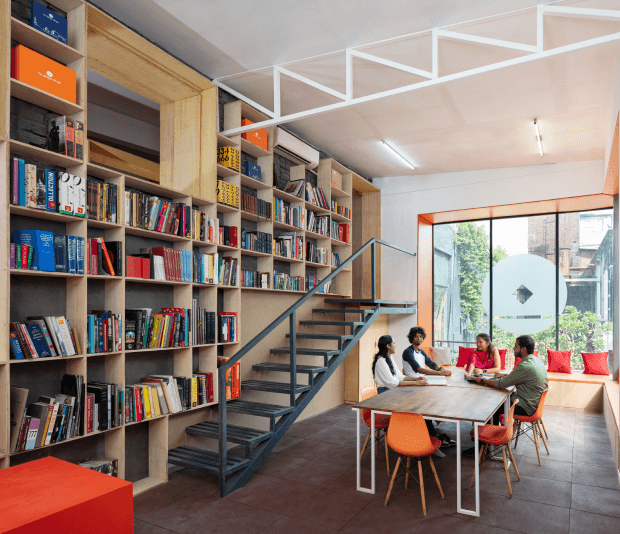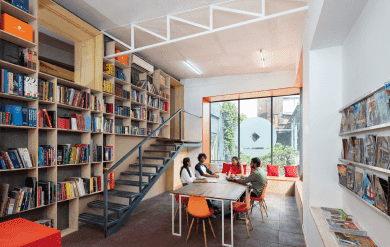The meaning and interpretation of fashion and textiles are changing with the increasing advancements in technology. Innovations like augmented reality, AI, 3D printing, automated production techniques, etc. call for designers who can cope with these changes and propel forward in this sector.
The Fashion & Textile Design Course at TDV encompasses the two seemingly specialist fields of fashion and textile design into one by highlighting their inherent relationship and enabling students to look at this realm holistically. It pushes the students to explore & embrace the relationship of the fashion sector with other sectors.
The scholastic curriculum and futuristic approach of the Fashion and Textile Design Course at TDV equips the students with the tools & techniques necessary to become a fashion designer who doesn’t only solve problems of today but also revolutionises the future for the better.
The students pursuing the Fashion and Textile Design Course at TDV question the stereotypical definitions of Fashion & Fashion design studies and learn to bring together the concepts of sustainability, environmental studies, and living traditions.
The integrated approach and versatile curriculum of the program allow the students to look at the domain in the larger context of India and the world.
Key focus areas include :
Making : The program involves learning the history & science of yarn, weaving, and knitting along with the Industrial manufacturing production and processes.
Surface: Key fashion and processes like dyeing, printing, and surface appliqués.
Manifestation: This includes illustration, Pattern making, Draping, and Construction of Garments and Lifestyle products.
The program focuses on the ideation and processes involved in designing & manufacturing clothing, footwear, fabrics, and other textile products, making it the best fashion design and textiles course and TDV the best fashion designing institute in Delhi.
Anyone with an eye for detail, who knows how to bring an aesthetic together. At TDV we encourage students who are curious, who are experimental, who see life through design.


The journey of every design villager at TDV is chalked out through a thoughtfully-curated curriculum. It is designed to support each student’s manifesto and helps them become aware of themselves and choose what kind of fashion designer they want to be in the future.
Students pursuing the two-year PG courses in Fashion Designing will understand the entire product cycle through the Making, Surfaces, and Manifestation modules.
The villaging and taskbox briefs are mostly the same for all the programmes but are manifestation-independent. The modules pan across the entire gamut of fashion and textiles, offering phenomenal exposure to the students without being limited to garments or lifestyle products.
India holds around 14 percent share in the production of textile fibres and yarn, and around 63 percent share in loom production in the global market. These figures indicate the scope in Indian market. After graduating as Master of Fashion Design, a student can choose to engage in their career as:
The Master in Fashion and Textile Design is an postgraduate programme in which students gain in-depth knowledge of fashion and textile design. They are also exposed to the process of designing fabric and fashion products and the factors which influence the design of it. The Fashion and textile Designing Course at TDV helps to understand fashion design, its making, marketing, manufacturing and communication in context with factors affecting the world like sustainability, big data and much more.
The admission process at TDV involves the following steps -
An end to end, integrated understanding of fashion and textile design -
The curriculum of The Design Village questions the stereotypical definitions of fashion and its education of being taught in isolation. It offers the programme in context with other design fields and events/changes occurring in the world through offering innovative electives shared with other design fields. This opens up new ways of looking at fashion.
Students who choose to pursue a Masters Course in Fashion and Textile Designing receive a recognized Master of Design degree. The course fee is INR 12,50,000 for two years and includes the tuition fee for an international semester. Other than this students one time fee for Registration, Security and Summer school security are applicable. Upto 100% Scholarships and funding options are available.
The course duration is 2 years.
An end to end, integrated understanding of fashion and textile design -
We have seen that fresh graduates can expect a starting salary range of INR 35,000 - 60,000 per month, depending on the brand and the opportunity. Mid level professionals (5 yrs -10 years) are likely to be in the salary range INR 60,000 - INR 100,000. Professionals over 10 years of experience can command salaries upto INR 150,000 - 200,000.
Yes it is absolutely possible to be a fashion designer even if you can not draw. Fashion stands for communicating and expressing your ideas with the world. The medium for this expression can range from anything like either drawing or having great digital skills.
Even though having a good eye for details like colour and shape is helpful in becoming a fashion designer, being great at art is not necessary. Drawing can be helpful, but it is not necessary. However, if you are not good at drawing, or if you don't feel like learning to draw, other digital skills are available to you.
Studying fashion design can lead to exciting and exciting careers, but the simple idea of jumping into fashion design can be overwhelming.Fashion design brief includes extensive research, full use of resources, fabrics, and collaboration with professionals to create styles and designs that appeal to a wider audience. The best way to learn all this is through studying about fashion.
The best and the most effective fashion designing course will not solely improve your artistic skills and knowledge, but also help you to respond to dynamic trends in fashion.These are the foremost helpful and vital skills that assist you to get a bright future in this fashion designing industry which you cannot acquire on your own.
Aspirants can study fashion design as a bachelor's or master's degree, and applicants can also complete short-term diploma or certificate courses in the field of fashion design.
We at TDV follow a 2-tier evaluation process for admission as follows -
The admission process at TDV involves the following steps -
It takes about four years for designers with a bachelor's degree to start their career before looking for a job in the fashion industry. Although most graduates find jobs in fashion or related fields after graduating from high school, it may take years for designers to gain recognition in the industry.
Fashion Designer, Textile Designer, Lifestyle Designer, Fashion Blogger, Brand Manager, Fashion Merchandiser, Fashion Illustrator, Fashion Stylist, Fashion Journalist, Fashion Photographer etc are some of the job opportunities for fashion designers.